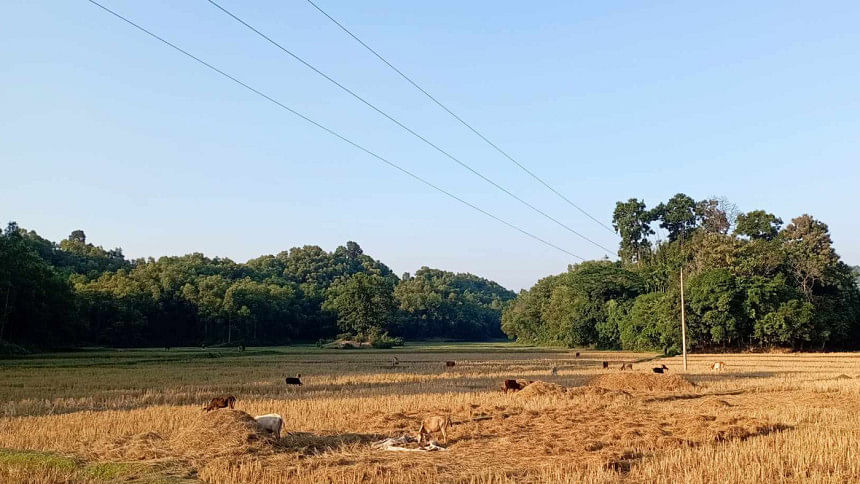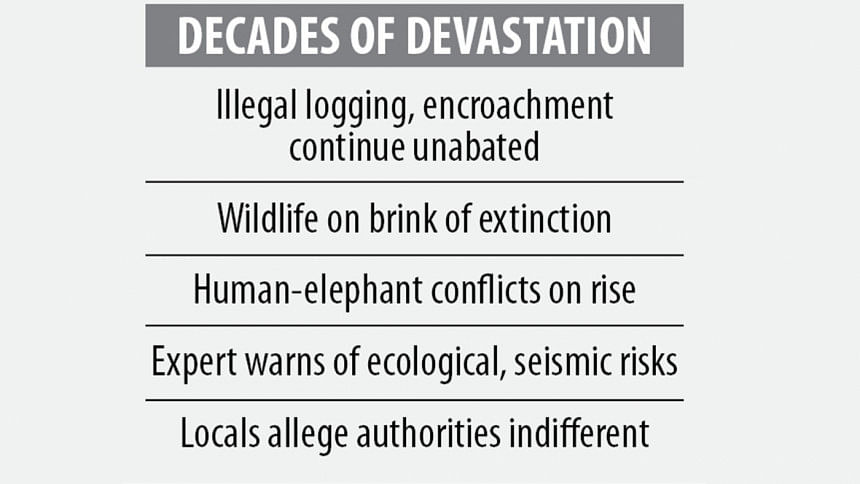Forests reduced to bare lands

The natural forest cover in Durgapur and Kalmakanda upazilas of Netrakona, adjacent to the Garo Hills of Mymensingh, is on the verge of disappearing due to decades of illegal logging and encroachment, alleged locals.
Despite the gradual loss of forested areas, no significant actions have been taken by the authorities to address the issue. Instead, a section of forest officials has reportedly been complicit in the actions of those responsible for cutting down trees and clearing forest lands, further accelerating the destruction, they claimed.
Large sections of forest in areas like Bijoypur, Maizpara, Laxmipur, Baromari, Lengura, Gobindapur, Panchgaon, and Mohishkhola have been destroyed over the years.
"These forests were once home to over 100 wild species, including elephants, tigers, leopards, deer, and hanuman langurs. Today, sightings of wildlife are rare, with only occasional visits by wild elephants crossing the border in search of food," said Rifat Ahmed Rasel, founder president of the animal rights organisation "Save the Animals of Susang".

"Indiscriminate logging, land grabbing, and the planting of harmful exotic species have left the forest barren over the past two decades, damaging its ecology, biodiversity, and geography," Rasel said.
Hillarious Nokrek, a resident of Kamarkhali village, said the destruction of forest land has led to increased human-elephant conflicts as elephants invade local areas due to food shortages, resulting in casualties on both sides.
Suranjan Hajong of Gopalpur expressed similar concerns.

Md Ohidur Rahman, regional coordinator of the "Bangladesh Resource Centre for Indigenous Knowledge", said the forests once thrived with indigenous trees like segun, gazari, sal, jarul, and shirish.
However, illegal logging has drastically reduced the forest, leading to significant habitat loss for wildlife, he said. Dr Md Azharul Islam, professor of environmental science at Bangladesh Agricultural University, warned of serious ecological consequences if forest depletion continues. "Mymensingh is at high risk of earthquakes, so protecting and replenishing natural forests with indigenous trees is crucial," he added.
Data from the Divisional Forest Office in Mymensingh show that the forest area in the division once spanned over 71,000 acres, including 38,911 acres of reserved forest across Mymensingh, Jamalpur, Sherpur, and Netrakona.
Over the past three decades, vast portions have been lost to illegal activities. In Mymensingh alone, 24,895 acres have been grabbed with similar losses in other districts.
Md Dewan Ali, Durgapur range officer, denied allegations of forest plundering or official involvement. "Felling of trees has been stopped in the four beats under this range for the last couple of years. No forest-related cases have been filed during this time," he said.
Divisional Forest Officer ANM Abdul Wadud said an ongoing afforestation project involving local communities would be completed within 12 years. "We will plant indigenous trees to restore the forest within a decade, ensuring food and shelter for wildlife," he said.

 For all latest news, follow The Daily Star's Google News channel.
For all latest news, follow The Daily Star's Google News channel. 



Comments